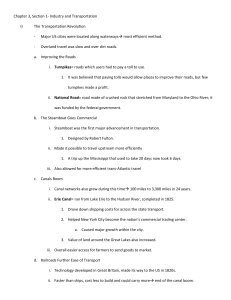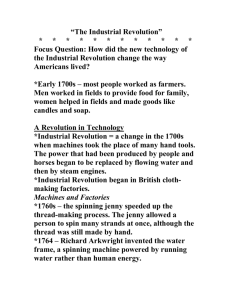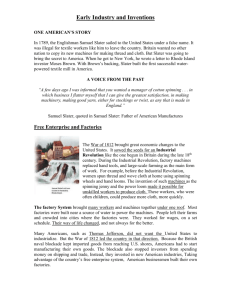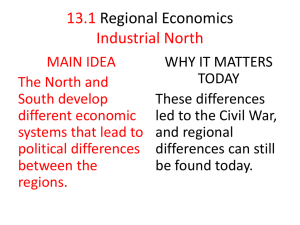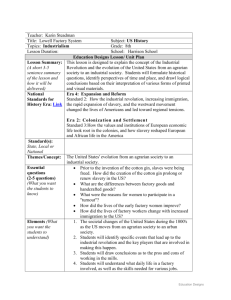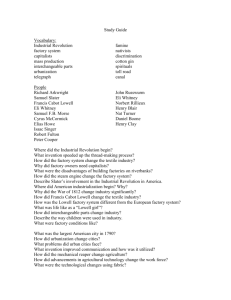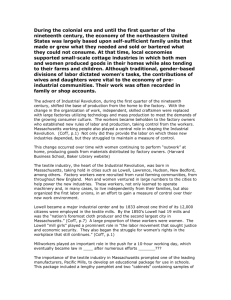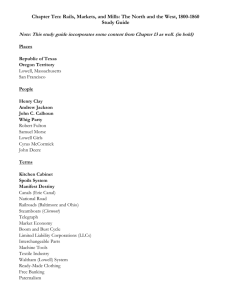Samuel Slater - The Sprintz Site
advertisement
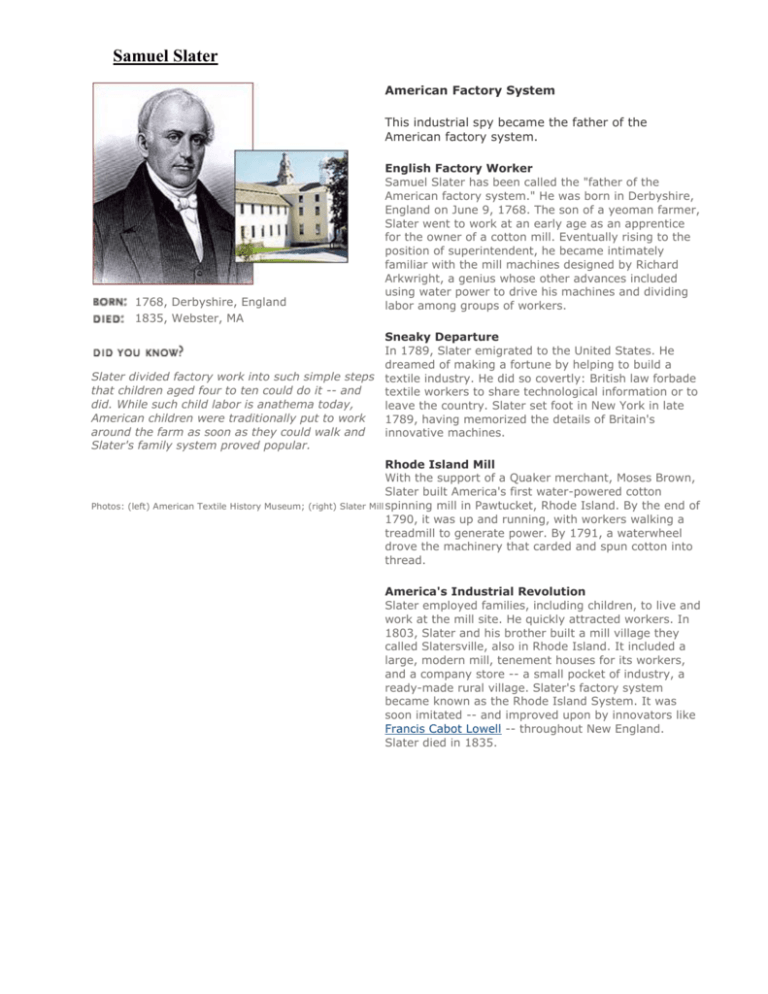
Samuel Slater American Factory System This industrial spy became the father of the American factory system. 1768, Derbyshire, England 1835, Webster, MA English Factory Worker Samuel Slater has been called the "father of the American factory system." He was born in Derbyshire, England on June 9, 1768. The son of a yeoman farmer, Slater went to work at an early age as an apprentice for the owner of a cotton mill. Eventually rising to the position of superintendent, he became intimately familiar with the mill machines designed by Richard Arkwright, a genius whose other advances included using water power to drive his machines and dividing labor among groups of workers. Sneaky Departure In 1789, Slater emigrated to the United States. He dreamed of making a fortune by helping to build a Slater divided factory work into such simple steps textile industry. He did so covertly: British law forbade that children aged four to ten could do it -- and textile workers to share technological information or to did. While such child labor is anathema today, leave the country. Slater set foot in New York in late American children were traditionally put to work 1789, having memorized the details of Britain's around the farm as soon as they could walk and innovative machines. Slater's family system proved popular. Rhode Island Mill With the support of a Quaker merchant, Moses Brown, Slater built America's first water-powered cotton Photos: (left) American Textile History Museum; (right) Slater Mill spinning mill in Pawtucket, Rhode Island. By the end of 1790, it was up and running, with workers walking a treadmill to generate power. By 1791, a waterwheel drove the machinery that carded and spun cotton into thread. America's Industrial Revolution Slater employed families, including children, to live and work at the mill site. He quickly attracted workers. In 1803, Slater and his brother built a mill village they called Slatersville, also in Rhode Island. It included a large, modern mill, tenement houses for its workers, and a company store -- a small pocket of industry, a ready-made rural village. Slater's factory system became known as the Rhode Island System. It was soon imitated -- and improved upon by innovators like Francis Cabot Lowell -- throughout New England. Slater died in 1835. Francis Cabot Lowell Consolidated Manufacturing This American industrial pioneer left as his legacy a manufacturing system, booming mill towns, and a humanitarian attitude toward workers. Bringing Industry to America In just six years, Francis Cabot Lowell built up an American textile manufacturing industry. He was born in Newburyport, Massachusetts in 1775, and became a successful merchant. On a trip to England at age 36, he was impressed by British textile mills. Like Samuel Slater before him, Lowell was inspired to create his own manufacturing enterprise in the United States. 1775, Newburyport, MA 1817, Boston, MA Risk Takers In 1813, back in Boston, Lowell and several partners formed the Boston Manufacturing Company. Lowell led them in both technical and business decisions. They introduced a power loom, based on the British model, Francis Cabot Lowell was a member of the prominent with significant technological improvements. And they Boston Brahmin family, which included statesman John found a novel way to raise money: they sold $1000 Lowell, Harvard University president Abbott Lawrence shares in the company (each worth over $10,000 in Lowell, civil war general Charles Russell Lowell, and 2002 dollars). The shareholder corporation they devised poet Robert Lowell. would rapidly become the method of choice for structuring new American businesses. Photos: American Textile History Museum Integrated Manufacturing The company built a tall brick mill building next to the Charles River in Waltham, Massachusetts, incorporating various mechanization technologies to convert raw cotton into cloth. The Waltham mill integrated the chain of tasks under a single roof, inaugurating what would become the American factory system of the nineteenth century. Waltham cloth gained immediate popularity. Mill Girls Another of Lowell's innovations was in hiring young farm girls to work in the mill. He paid them lower wages than men, but offered benefits that many girls, some as young as 15, were eager to earn. Mill girls lived in clean company boardinghouses with chaperones, were paid cash, and benefited from religious and educational activities. Waltham boomed as workers flocked to Lowell's novel enterprise. Industrial Powerhouse When he died of an illness in 1817, Lowell left his Boston Manufacturing Company poised to expand and reward its investors handsomely. In 1821, dividends were paid out at an astounding 27.5%. In 1822, Lowell's partners named a new mill town on the Merrimack River, Lowell, after their visionary leader. New England had embarked on the transformation of its economy from farming to industry. Borrowed from http://www.pbs.org/wgbh/theymadeamerica/whomade/.html
